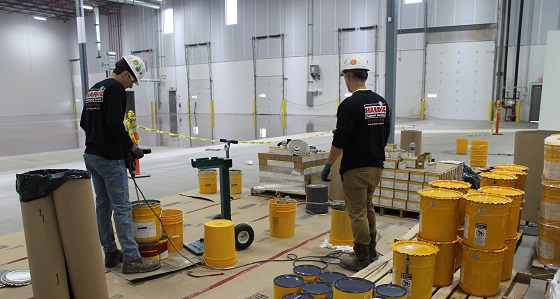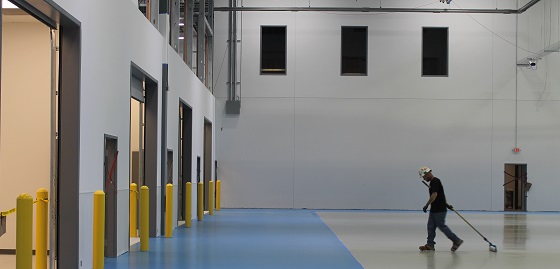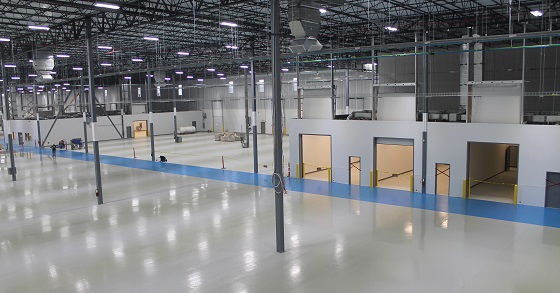In late 2019 and early 2020, the crew at Hardig Industrial Services was asked to work on a project at a newly constructed industrial manufacturing facility in West Chester Township, Ohio. Based in nearby Cincinnati, it was a convenient job for the crew at Hardig, which is well respected as a leading (and award-winning) contractor throughout the region.
“This was an open-bid project,” said Kevin Kipp, co-owner and project manager of Hardig. “There were five bidders. The cool thing was that we were fourth out of the five bidders when it came to price. We were not the low bid, but we still got selected based on experience, knowledge, post-bid interview, and the confidence in getting it executed on their time frame.”
NorthPoint Development ultimately chose Hardig for this job, and it appears the higher investment paid off. Here’s how they did it.
Explaining ESD
The good news was that facility’s end user, which wishes to remain unnamed, had a brand new substrate thanks to new construction. The bad news is that the substrate and unique facility needs still brought its own challenges, along with the Hardig crew having to work around numerous other trades on site.
“The facility uses proprietary technology to manufacture products from specialty alloys for various industries,” Kipp said. “The facility required electrostatic dissipative [ESD] epoxy flooring over 150,000 square feet [13,935.5 m2] due to the manufacturing process. Their process is 3D printing, using basically metallic alloys or pigments. They’re able to build structures or components out of powdered alloys.”
“With ESD, you know there’s certain dangers of electricity and static discharge,” Kipp continued. “You’re going to be protecting sensitive parts from damage, there’s employee safety hazards, and obviously risks of explosion. This specific project had sensitive equipment in their processes. Given that they’re working with powder alloys, there was some explosives potential. So, they needed to make sure that the floor was well grounded, in conjunction with equipment strapping, and [to wear] shoes that the static could dissipate and flow through the floor… until it can be removed from the room at at a grounding point.”
On this project, the Hardig crew grounded the floor with one grounding point every 1,000 square feet (92.9 m2). “In all, there were approximately 150 different grounding parts throughout the building, whether it was to a part of the structure or into an electrical ground point in a room, or a process area,” Kipp said. “We were making sure that all the floors would test appropriately.”

Moisture Mitigation
This particular project was supposed to start in the summer of 2019, with the Hardig crew coming in after a handful of other trades. But it ended up being the winter by the time Hardig’s team was actually able to do their work, given a few unexpected issues.
“We had a lot of interior moisture and humidity that was causing moisture on the slab and moisture in the joints,” Kipp said. “So we ended up having to pull off for a few weeks until they got some air handling units.”
“The slab condition was about a year old by the time we got to it,” Kipp added. “But it still had high moisture content just because it didn’t have any vapor barrier under it…. The substrate below the concrete didn’t allow for much moisture to move out of it… until we shot blasted it and opened it up.”
Those moisture concerns also led to the crew choosing to bring in a specialty primer. “When we used our Tramex meter, they were reading above the typical threshold of the specified product,” Kipp said. “So, we had to upgrade the customer to Sika’s high-moisture tolerant primer. We went with a high-build, moisture-tolerant epoxy, or a vapor barrier, essentially.”
Hardig’s crew averaged six to eight workers on a given day, all wearing safety and personal protective equipment (PPE), such as hard hats, safety glasses, steel-toed boots, and 3M respirators. “All OSHA-required PPE was used for surface prep,” Kipp said.
Three-Point Play
Once the site was ready for flooring work, Hardig basically divided it into three sections of 50,000 square feet (4,645.2 m2) each as part of a plan to allow full access to other trades for the remaining two sections, as needed.
For a given area within each section, the crew’s work scope essentially went as follows:
• Surface preparation activities generally took one to two days, Kipp estimated, while each of the three coating layers were applied on a given day and allowed to cure overnight.
• Using a Blastrac 1-15DS shot blaster, surfaces were prepared to achieve the Concrete Surface Profile (CSP) 3–4 standard, as defined by International Concrete Repair Institute (ICRI).
• Joints were filled using the Edge-Pro 90 by Metzger McGuire.
• The Sikafloor-1610 moisture-tolerant primer was applied at an average of 16 mils (406.4 microns) dry film thickness (DFT).
• The Sikafloor-200 C ESD epoxy went down at an average of 14 mils (355.6 microns) DFT, with 36-grit aluminum oxide.
• Finally, the Sikafloor-340 ESD urethane was applied in two coats, at 3–5 mils (76.2–127.0 microns) DFT per coat.
• In select locations, the finishing touch involved applying large blue aisleways with yellow line striping.
Coatings were applied by hand using Midwest Rake tools by Seymour-Midwest and Contractor Series rollers from Sherwin-Williams. They utilized CS Unitec mixing drills for the coatings.

“We couldn’t spray due to the solids content of the material,” Kipp said. “Typically, when you’ve got a high-solids, ESD-based product, there’s going to be a carbon fill in it. Something like that is not a sprayable product. It’s more of a squeegee, self-level, and backroll.”
Kipp said the ESD material was approximately 70–80 percent solids since it has a small solvent component to it. However, everything else was at or near 100 percent solids.
“When we did certain application days, we might have had 10 guys there,” Kipp recalled. “We could have two guys in the mixing station and five or six guys out on the floor who were actually squeegeeing and rolling materials, along with one or two guys running product to them. It really depended on how big the chunk [of room] was.”
It was a good thing that the application went in orderly fashion because the Hardig crew was racing against the clock from a material perspective. “Since we had major delays on the front end, and we were installing a product that had a shelf life that was to expire in February, we had to get it done,” Kipp concluded. “The good thing was that it didn’t affect the installation, and Sika stood behind the material, and everything went really well. It’s awesome.”

Rave Reviews
In all, Hardig completed its scope within approximately 60 days. “The customer was happy,” Kipp said of the immediate reaction. “They were definitely very proud of the way the floor looked. Aesthetically, everything looked really great.”
From there, the customer was “very cautious” in bringing in its large equipment. In all, Kipp estimates that it took about a 1.5 years until the customer had set up all of its equipment to begin processing operations. But now, two years later, it’s so far, so good.
“We’ve had a lot of good feedback,” Kipp added. “We had Sika come in and do all of the technical testing to check the ESD limits and ranges, and everything passed. We had no areas that we had to redo any sections or any kind of work. The punch list was very minimal.”
“As large as this job was, with the crew size and our ability to work with others, I think that was a very, very productive site,” Kipp concluded.